| Your browser is not supported. | ||
|
Please browse our site using any of the following options:
| ||
How To Choose A Hiking Backpack Or Bag
Packing a bag and heading off on an adventure is always good for the soul. Whether it's a hike, bike ride, trail run, weekend getaway or trip overseas, the bag you take is important. It can be the difference between an amazing experience and unnecessary frustration. This Buying Guide talks you through choosing the best backpack or bag for your needs so you're all set for everyday life in Australia and epic adventures anywhere.
What is the best backpack for travelling?
There's no one-size-fits-all answer, because what's best for one person might not suit someone else. The best backpack or bag for you depends on your particular needs:
- What you'll be using the pack or bag for (a weekend away, overseas holiday, hiking or biking?)
- How often and how long you'll be using it for at a time (every day, for a day, week or month?)
- How much stuff you want to take (will you pack light or buy things to bring home?)
- What kind of conditions you'll face (will the weather be hot, rainy or snowing?)
- How far you'll be carrying it (long distances every day or just from the car to the plane?)
- Whether you'll be taking the kids (and if you'll need to carry some of their gear for them)
- Whether you'll be in remote locations (so will need to pack food, water and first-aid supplies)
- How long you want it to last (for a few trips or many years of use and travelling to come?)
What backpack or bag should you buy?
Working out which backpack or bag to buy is easier when you break it down in into these six steps:
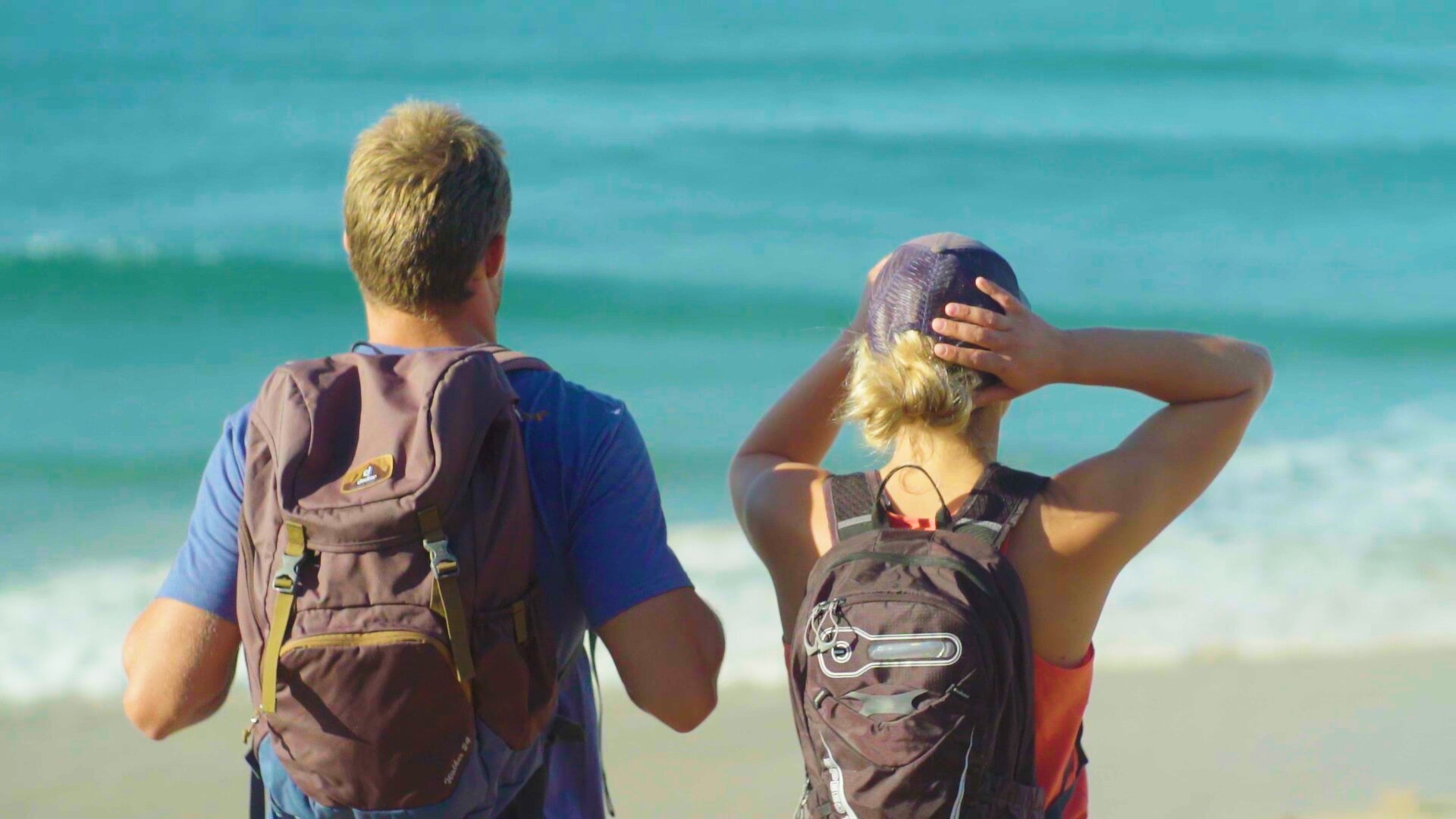
1. Type
There are a few different types of bags and backpacks, and the one that's best for you depends on what you'll be using it for and your personal preferences.
Day Packs
- Are compact and light and can carry just enough essentials for one day.
- Are perfect for heading out for the day, to work, on a bike ride, run or hike.
- With a belt that clip around your hips won't bump around when you move.
Travel Packs
- Are much larger so you can pack clothes and travel essentials for a trip of a month or more.
- Are designed to give you comfort and support when carrying your pack around often.
- Have a belt that sits on your hips so it's secure and the load is on your legs (not your back).
- Are ideal for those doing a lot of travelling from place to place, especially backpackers.
- Are not suitable for hiking (as they're not designed for all-day comfort and the weather).
- Can have a removable day pack which is handy for sightseeing.
- Can also have wheels and a handle so they can be wheeled along on even ground.
- With wheels are ideal if they're only carried on your back now and then for short stints.
Hiking Packs
- Are designed with hiking essentials, weather, freedom to move and comfort in mind.
- Properly support good posture without weighing you down for days and weeks on end.
- Are for those who can't risk tearing or breakages, or gear getting weather damaged or lost.
- Can be the difference between carefree hiking and feeling annoyed and uncomfortable.
- Are a lot lighter, stronger and more comfortable than the old backbreaking hiking packs.
- Have a belt that sits on your hips so it's secure and the load is on your legs (not your back).
- Are narrower and taller than travel packs so you're balanced and can fit in narrow spaces.
Duffle Bags
- Are slung over your shoulder (just like army officers in the movies).
- Can be used for travelling, camping, the gym or weekend getaways.
- Are perfect for travelling light on short trips with one destination.
- Large duffels can be hard to carry when full or for long distances.
- Can have wheels to pull them along when they're full and heavy.
Dry Bags & Waterproof Cases
Depending on what you'll be doing and where you're going, you may want a:
- Dry bag - to keep valuables like your phone, wallet etc. dry if it rains or you're kayaking.
- Waterproof case - to keep important documents like passports and maps protected.
Covers, Liners & Accessories
Depending on the bag or pack you buy, you may also want a:
- Rain cover - to cover your whole pack and keep everything inside dry.
- Pack liner - to put inside your pack as another layer of protection to keep your gear dry.
- Organisers - to keep undies and socks together, and keep dirty or wet clothes separate.
2. Size
Bags and packs range in size from 10-110 litre:
- Too big - you'll be carrying extra weight for no reason and be uncomfortable.
- Too small - you won't be able to pack everything you need to be happy and safe.
How to choose a hiking pack?
Start by thinking about what you want to take with you. You'll need enough space for:
- Water if you'll be out hiking, kayaking or sightseeing.
- Food - snacks, lunch plus dinner and cooking fuel for overnight hiking and camping.
- Technology - your phone, computer, music speaker, camera and GPS.
- Clothes - your jacket, shoes, and clean, dry clothes to change into.
- Sleeping gear - a tent, sleeping bag and mat if you're camping or doing a multi-day
How much should a hiking pack weigh?
If you're carrying your pack on all-day hikes it will be easier to carry if it's light. Check bag weights when comparing different options and consider choosing a pack that's light so the bag itself doesn't weigh you down.
Keep in mind that the size you choose is a trade-off between space and weight:
- The bigger the bag the more you can fit in it, but the heavier it will be to carry.
- The smaller the bag the less it'll fit in it but the lighter and easier it will be to carry.
10-30L
These packs are best for:
- Short, half-day hikes
- School and work days
- Touring towns and cities
- Cycling and trail running
30-50L mid-size packs
These packs are best for:
- All-day or extended hikes
- 1-2 day overnight trips
- Weekend camping
- Travelling light for up to a week
50-110L Hiking packs
These packs are best for:
- 3-7 days if packing a lot
- Trips of more than a week
- Carrying 15-25 kilograms
- Longer camping and hiking trips
- Backpacking around the world
- Long distances and rough terrain
- Cold weather clothing
Winter clothes are bulkier than summer clothes, so you'll need a bigger bag for a week in the snow than a week in a resort.
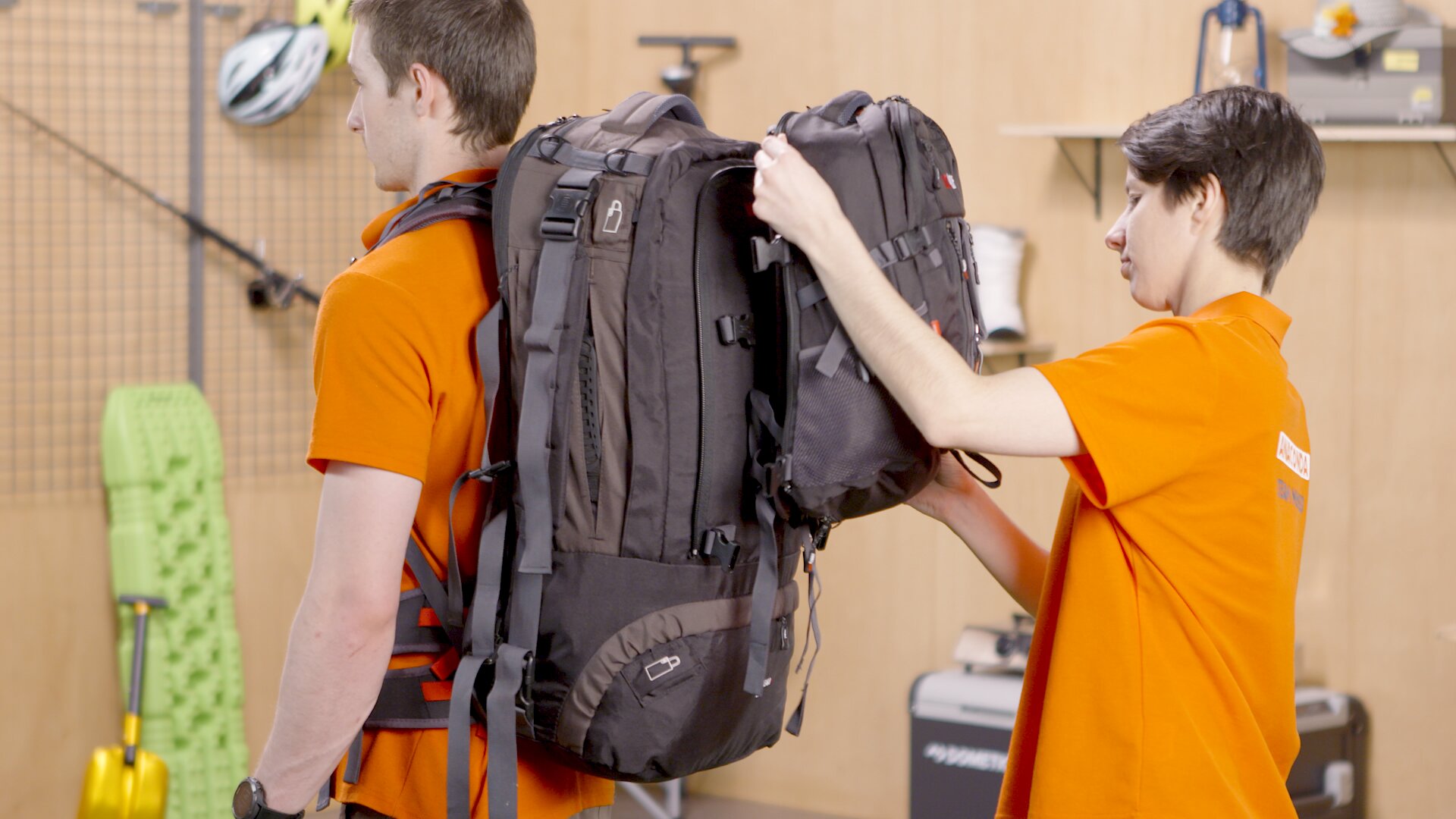
3. Fit
How well the backpack fits you is just as important as the size. The fit determines how comfortable you'll be when you're wearing it and walking around, so it has to be right. Get it wrong and you could end up extremely uncomfortable, with back pain or an injury.
Fitting the pack to your back is easy once you know how, and it's not your height that matters most, it's the length of your torso (from hip to neck).
How to measure your torso?
- Tilt your head forward and find the bony bump just below where your shoulders and neck meet. This is your 7th cervical (or C7) vertebra-and the top of your torso.
- Ask someone to help by dropping a soft measuring tape straight down from your C7 to where you feel your hipbones start (the top of your hips).
- Write down this measurement which is your torso length.
Torso length and backpack size
Just like clothes, different backpack brands have different size charts, so based on your torso length, you could be a small in one brand and medium in another brand.
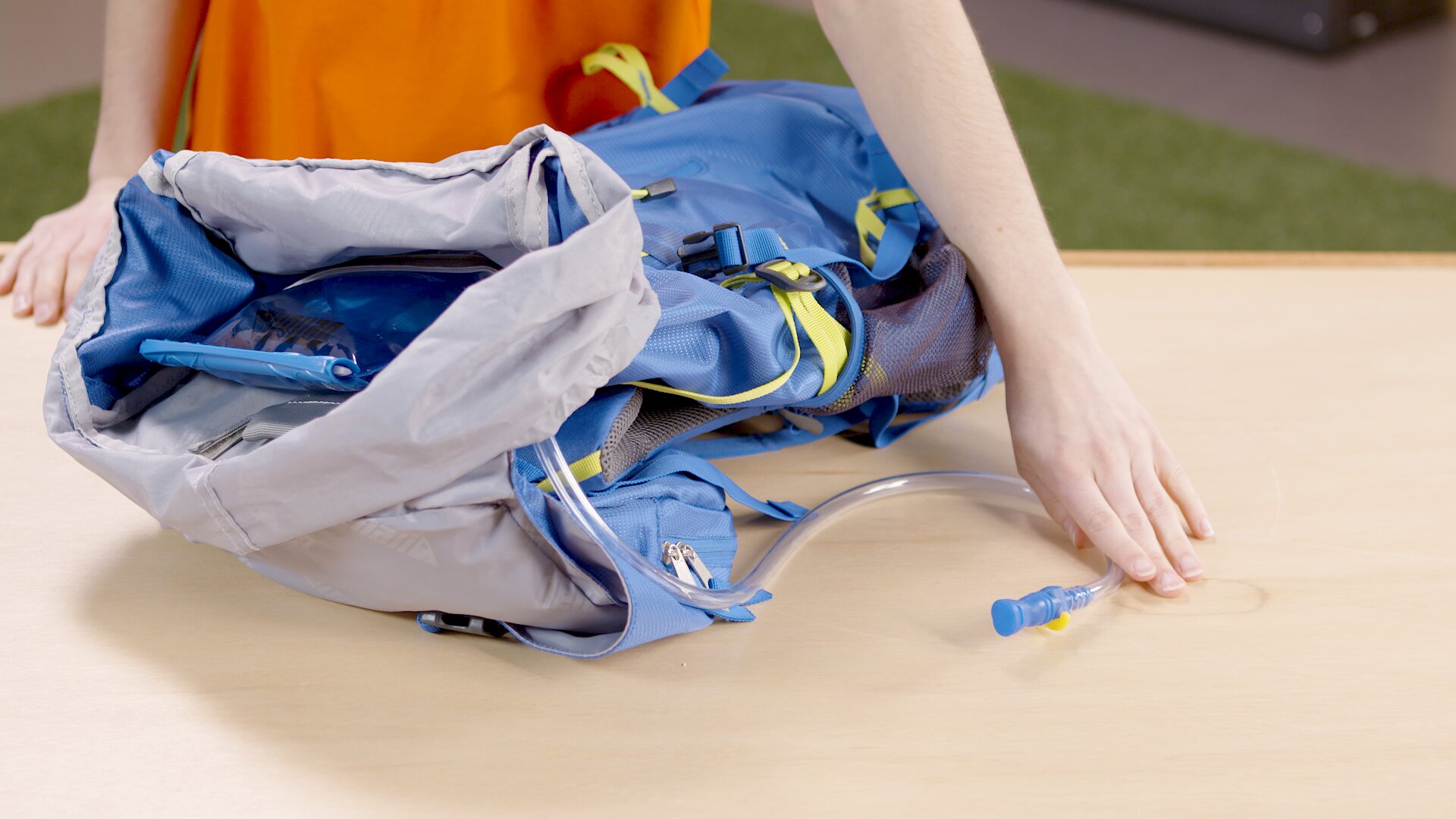
| Body Size | Torso Length | EVOC Protector Size |
| 155cm - 170 cm | 38cm - 43cm | S |
| 170cm - 192cm | 44cm - 50cm | M / L |
| 192cm - 200cm | 51cm - 56cm | XL |
Some backpacks have a back panel with a fixed length, whereas others can be adjusted to suit your torso length.
To properly fit your backpack for maximum comfort and safety, you'll need to:
- Adjust several straps so most of the load is on your hips and your leg muscles take the load.
- Have 5-10kilograms of weight in the backpack when you're doing the fitting.
To get a backpack that's perfectly fitted to your body, visit your nearest Anaconda store.
How to fit a backpack?
1. Adjust the shoulder and hip straps
- Roughly loosen or tighten shoulder straps to your size before you put the pack on.
- Put the backpack on.
- Move the hip belt until the padding hugs the top of your hip bones.
- If the hip belt sits too low or too high, tighten or loosen the shoulder straps.
- Fasten the hip belt and tighten until it's snug and secure (without pinching your hips).
- Check the padded section of the hip belt to make sure it's on the top of your hips.
- Readjust the shoulder straps, hip belt and the tension until you hit the sweet spot.
- The belt padding should extend slightly beyond the front point of your hipbones.
- You also need at least 2.5cm of clearance on either side of the centre buckle.
2. Tighten the shoulder straps
- Pull down and back on the ends of the shoulder straps to tighten them.
- They should wrap closely around your shoulders but NOT carry significant weight. If they are, you'll be putting undue stress on shoulder, neck and upper-back muscles.
- Check to see that the shoulder strap anchor points on your pack are 2.5-5cm below the top of your shoulders, roughly at the top of your shoulder blades. If not, then either your hip belt is at the wrong level or your pack's torso length is incorrect.
- If your shoulder straps are too tight they can cause shoulder pain.
- Loose straps can cause the pack to sway from side to side and throw you off balance.
3. Adjust & tighten the load lifter straps
- These connect the top of the shoulder harness to the back panel anchor point.
- When tensioned, they should angle back toward the pack at roughly 45 degrees.
- Don't overtighten the load lifter (excess tension can feel fine now but pinch later)..
4. Tighten the chest strap
- If you don't make the chest strap taught your shoulder straps slip off.
- Slide it until it's a comfortable height across your chest (2.5cm below the collarbones).
- Buckle and tighten it so the shoulder strap width allows your arms to move freely.
- Don't overtighten it (it can distort the fit, constrict muscles and restrict breathing).
5. Ask yourself:
- Do I feel completely comfortable? (If no, make adjustments or try another pack)
- Is the backpack pinching anywhere? (If yes, make adjustments or try another pack)
- Can I move around, squat and lift my head freely? (If no, adjust it or try another pack)
Women's Backpacks
Some brands have created backpacks for women or smaller frames in general which are:
- Shorter and narrower.
- Designed to cradle the hips.
- Contoured for chest-strap comfort.
Kids' Backpacks
Some brands make children's backpacks which are:
- Smaller in size (because kids aren't strong enough to carry as much).
- Adjustable so the torso length can be increased as the child grows.
Cotton, Canvas & Polycotton | Nylon & Polyester | |
Most waterproof (once weathered/seasoned) | Yes | No |
Fastest drying | No | Yes |
Sturdiest | Yes | No |
Lightest | No | Yes |
Most breathable | Yes | No |
Mould & mildew maintenance required | Yes | No |
Cheapest | No | Yes |
Longest lasting | Yes | No |
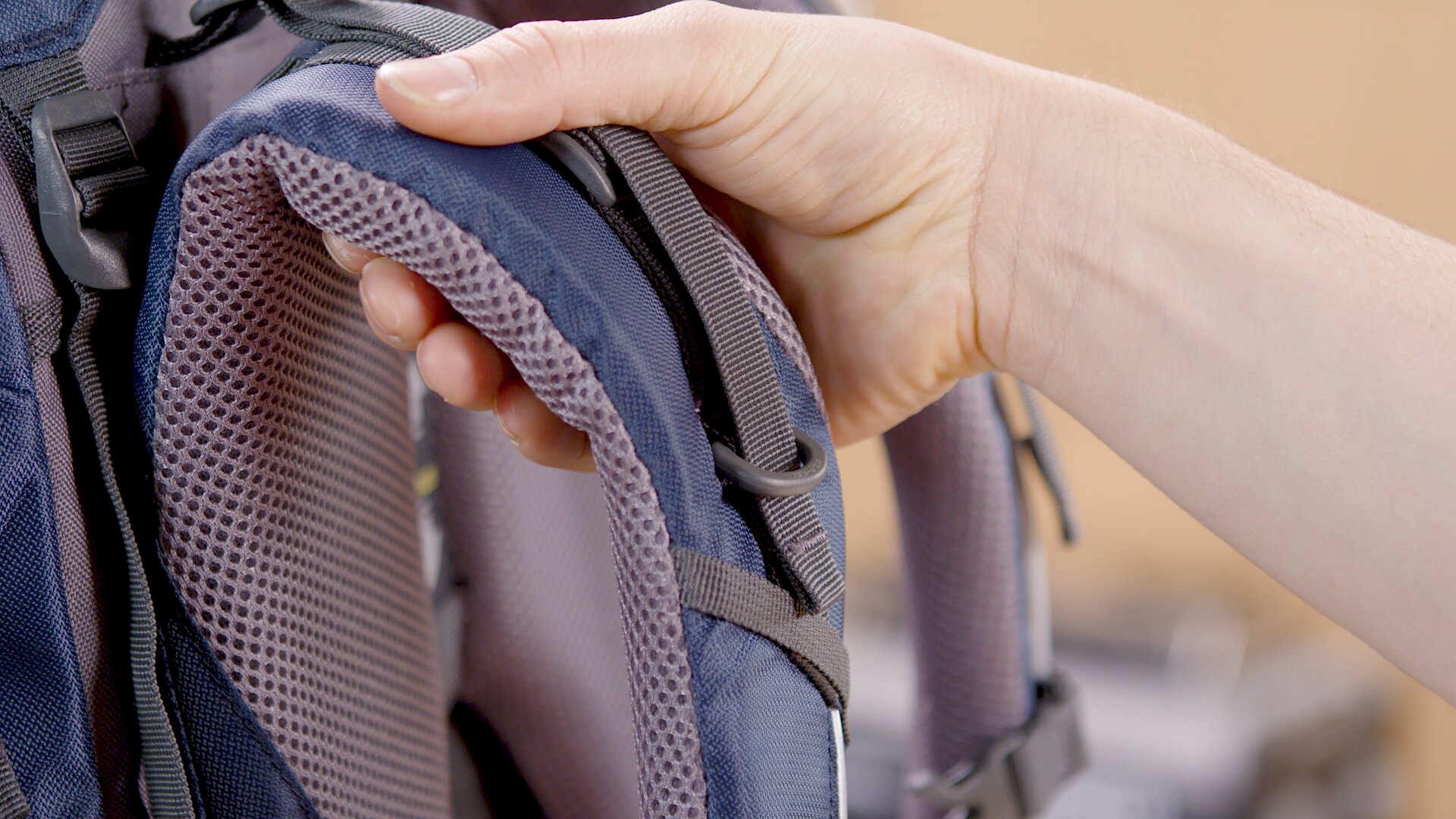
4. Comfort & Convenience
How the bag or pack has been designed and made determines how comfortable you'll be and how easily you'll be able to access what you want.
The first thing that affects your comfort is the suspension system, which should distribute the pack's weight so it's not on your shoulders but transferred to your legs via your hips.
Hip Belt
The hip belt on a backpack:
- Secures your bag to your body so it doesn't move around when you walk.
- Ensures most of the pack weight is supported by your leg muscles (not shoulders).
- Can have padding and lumbar support which makes heavy packs more comfortable.
- Can have built-in zip pockets on the front of the belt for easy access while you're walking.
- May restrict movement if you're skiing, snowboarding or climbing, so go for a minimal belt.
- Needs to sit on top of your hips (feel for your hip bones which are lower than your waist).
- Some models can be perfectly moulded to your unique hips using heat.
Shoulder Straps
The two straps that go over your shoulders:
- Can be padded so the straps don't rub against your body and cause painful chaffing.
- Should sit snug across your shoulders and be at least 5cm below your armpits at the front.
Load Lifter Straps
The load lifter straps:
- Connect the shoulder straps to the pack and lift the weight of the load off your shoulders.
- Prevent the pack pulling away from your body and putting pressure on your lower back.
- Are just below the tops of your shoulders (near your collarbone).
- Should be gently tugged until they're snug (not too tight) to take weight off your shoulders.
- Should form a 45-degree angle from the shoulder straps to pack (if not, try another pack).
Chest Strap
The sternum strap:
- Clips across the top of your chest (or sternum).
- Connects the two shoulder straps so they don't slip off.
- Makes the pack more secure and stabile, so uneven ground doesn't throw you off balance.
Storage Straps
Some packs have storage straps to clip your jacket or sleeping bag to the top of your bag.
Compression Straps
Compression straps:
- Are side straps you can pull tight to make the backpack more compact and stable.
- Can sometimes be used for carrying your snowboard or skis.
Padding & Ventilation
A backpack that has padding on the back panel:
- Stops whatever's inside sticking into your back uncomfortably.
- Can be made from foam (which can get sweaty) or more breathable mesh.
Packs with mesh allow air flow between your back and bag so you're not too hot and sweaty.
Access
Different backpacks have different ways you can access what's inside:
- Top-opening - the most traditional design and all you need if using a waterproof pack liner.
- Bottom-opening - to store things like your sleeping bag at the bottom of your backpack.
- Side-opening - a side zipper makes it easier to get to things in the depths of your bag.
Pockets & Hooks
Some packs and bags have:
- Outside and inside pockets to keep everything organised and within reach.
- Outside pockets that are perfect for water, snacks, your phone and camera.
- A shovel pocket on the outside to carry a shovel for bush toileting and shovelling snow.
- Inside pockets that are great for socks, underwear and separating clean clothes.
- A hook or loop on the top for hanging up your bag when you're showering.
Attachment Points
Backpacks can have a few points for attaching different things you may need:
- D-shape attachment points on the shoulder strap for your compass, sunscreen etc.
- Clip on points and gear loops for things like walking poles, climbing tools and skis.
Rain Cover
To protect everything inside your pack from rain and snow, backpacks can have a rain cover:
- That comes attached to the backpack inside a storage pocket.
- That you buy separately to suit the size of your pack.
You can also use dry bags inside your pack to protect your gear.
Water Bladder
If you'd rather use a water bladder with an easy-access sipping straw than a water bottle:
- Some packs have external sleeves for a water bladder (sold separately) for easy refills.
- Some packs have internal sleeves for the bladder and a hole for your sipping straw.
The Frame
The frame is your backpack suspension system, and it positions the load you're carrying.
Backpacks can either have:
- No frame - day packs usually don't have a frame (they're not heavy enough to need one).
- An internal frame - inside the pack to minimise movement and help you stay balanced.
- Keeps the load close to your spine and the weight on your hips.
- Best for active outdoor activities where balance is important.
- An external frame - has a metal frame on the outside of the pack which you can see.
- Best for walking with big, heavy loads (you can walk tall with the weight on your hips).
- The load is further away from you so it's less stable (use poles for hiking stability).
- Allows you to walk with better posture (because you don't need to lean forward).
- Creates air flow between your pack and back so your back doesn't get hot and sweaty.
Extra Space
Some packs have a collar you can pull up to create more space (but the fabric isn't usually as tough as the rest of the pack).
Other types of bags
When it comes to the comfort and convenience of other kinds of bags:
- Two-in-one backpack/wheelie bag wheels can be uncomfortable if worn too long as a pack.
- Shoulder bags are easier to carry one-handed when handles are connected in the middle.
- A D-shaped opening opens up duffel/sports bags more for easier access to what you want.
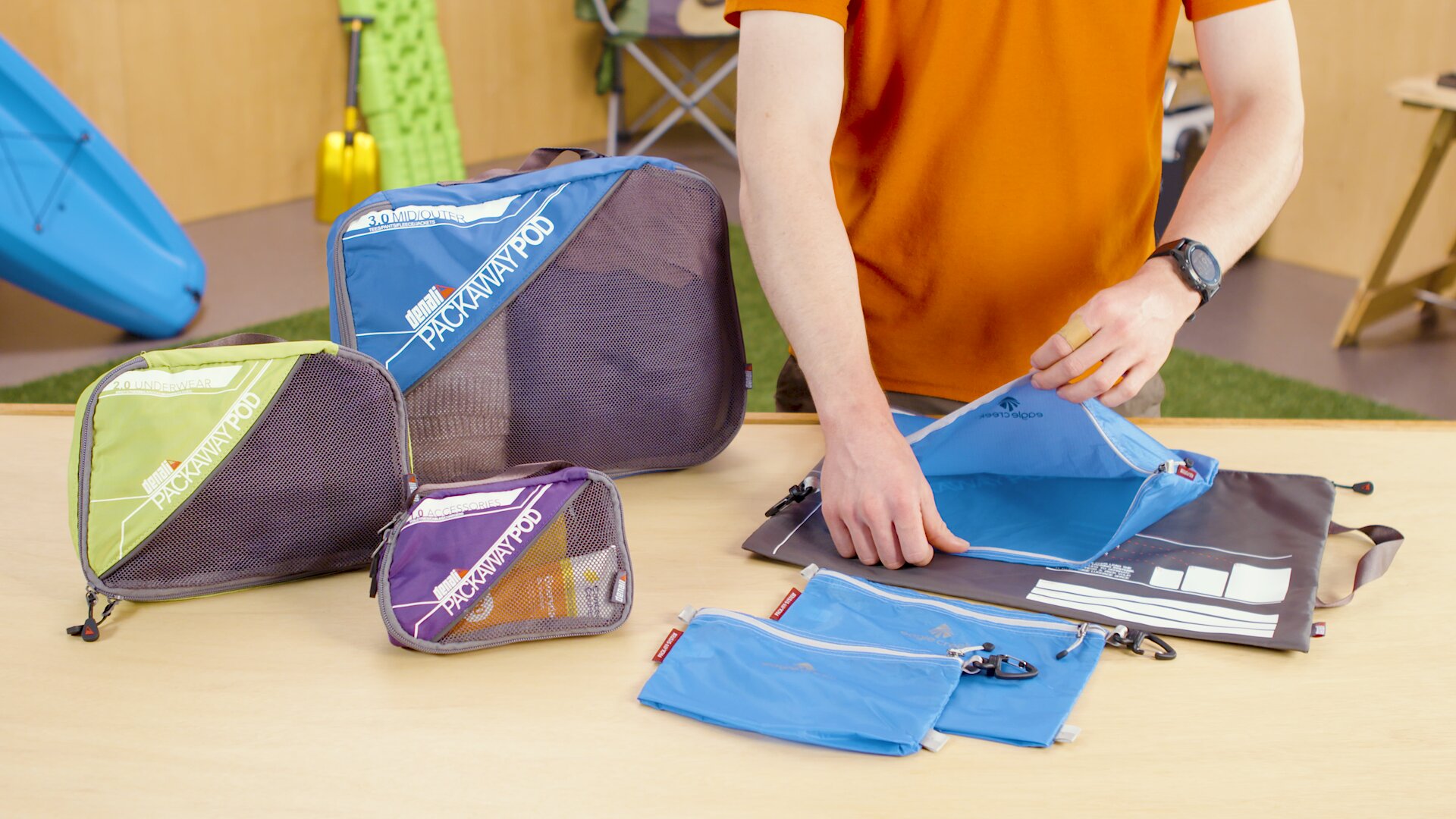
5. Quality
When you're weighing up which bag to buy, think about quality versus cost:
- Nylon and low-denier packs are the cheapest but won't last as long as high D/canvas packs.
- Travel packs are usually cheaper than hiking packs.
- Hiking packs are the most expensive packs but essential when you need reliability on a long trek, or are facing extreme weather conditions.
When it comes to how much you should spend:
- If you just want a bag the kids can use for sleepovers, a cheap one should do the trick.
- Cheaper packs tend to be less waterproof and less durable, so you get what you pay for.
- For comfortable hiking and travelling for years to come, it's worth spending more on a good-quality pack.
How much are bags and packs?
Anaconda has:
- Day packs from $10 to $220
- Travel packs from $140 to $490
- Hiking packs from $50 to $450
- Dufflel bags from $25 to $250
- Lifestyle/gym bags $40 to $50
When you go to the Camping & Hiking section on the Anaconda website, select Packs & Bags. You'll see tick box filters down the left hand side of the page which make working out which bag to buy easier and faster because you can choose to filter what you see by:
- Price - so you only see bags within your budget on the page.
- Deal - so you only see bags that are on sale or at clearance prices.
- Size - so you only see bags in the size you want.
- Brand - so you can browse specific brands you know and like.
Other Camping & Hiking Essentials
Check out Anaconda's range of Camping & Hiking products available online or visit your local store.